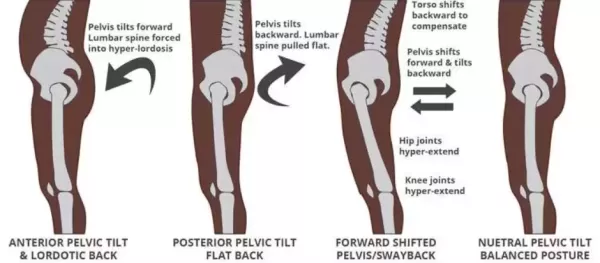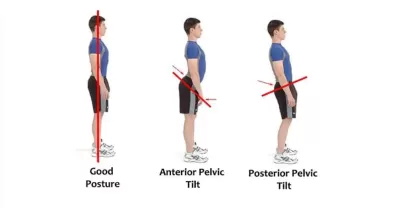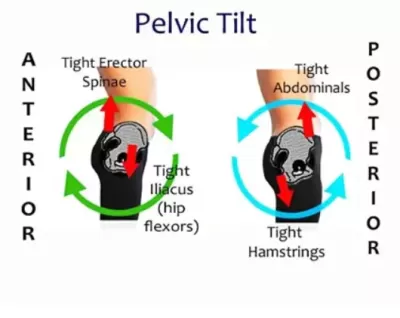Anterior VS Posterior Pelvic Tilt: Difference And Exercises
Anterior Vs Posterior Pelvic Tilt: What is The Difference?
Having a good pelvic posture in your body is very important for better muscle functionality in your whole body, less pain in your back and sports performance. Deviation from a normal pelvic position is common, so you may have heard of anterior and posterior pelvic tilt, the two most ‘popular’ pelvic posture issues that you need to take care of. Researching more about anterior vs posterior pelvic tilt, here is what I found out:
The difference between anterior and posterior pelvic tilt is enormous, starting from the way those pelvic postural issues arise, how they influence your body function and how you should treat anterior or posterior pelvic tilt. Let’s see first what is causing anterior and posterior pelvic tilt, and afterward what you can do to improve pelvic posture.
| Anterior Pelvic Tilt | Posterior Pelvic Tilt |
|---|---|
| Weak Glutes and Abs | Weak Hip Flexors and Lower Back |
| Tight Lower Back and Hip Flexors | Tight Abs and Hamstrings |
| Increased Lordosis | Flat Back |
| Reduced Hip Extension | Knee hyperextension |
Why Do I Have Anterior or Posterior Pelvic Tilt?
Anterior Pelvic Tilt
credit: starkwoodchiropractic
Anterior pelvic tilt happens when your pelvic rotates forward (anteriorly), and that’s causing your lumbar spine to curve into lordotic posture. The following muscles can cause anterior pelvic tilt:
- Tight paraspinal muscles (erector spinae muscles).
- Tight hip flexors.
- Weak abdominal muscle (rectus abdominis).
- Weak glutes.
The tight muscles causing anterior pelvic tilt are muscles in your lower back (paraspinal muscles) and the front of your tight (hip flexors), while the weak ones are glutes (maximus, medius and minimus) and abdominal muscles.
Prolonged sitting with overarching your back will emphasize the tightness of muscles in your lower back and front of your tight. Prolonged sitting with poor posture is the most common reason for anterior pelvic tilt.
You can also get anterior pelvic tilt if you are:
- Physically inactive.
- Don’t train your glutes/abs.
- Overarch your lower back during squat, deadlift of standing military press.
Contributing factors for anterior pelvic tilt are:
- Loss of hip extension movement.
- Knee hyperextension.
- Foot pronation.
- Tight hamstrings.
The anterior pelvic tilt is more common than the posterior pelvic tilt. You should know that slight anterior pelvic tilt is normal and around 85% of healthy males and 75% of healthy females have pelvic rotated slightly forward. Around 6-7 degrees of forwarding pelvic rotation is accepted as slight anterior pelvic tilt.
Posterior Pelvic Tilt
With posterior pelvic tilt, your pelvis rotates backward and this will give the appearance of a flat back and buttocks. Your hips will be pushed forward which results in a swayback posture.
Having a flat back means you have lost some degree of lordosis in the lower back. Lordosis is the inward curve of the lower back, and according to research, loss of lordosis leads to increased pressure on the intervertebral discs in lumbar spine and back issues.
Tight abdominal muscles and hamstrings can shift your pelvic into posterior rotation. Since these muscles tend to be weak, they rarely are responsible for posterior pelvic tilt.
With posterior pelvic tilt are glutes (maximus, medius and minimus), hip flexors and paraspinal muscles (erector spinae muscles) weak.
The most common reasons for posterior pelvic tilt:
- Prolonged sitting with slouched back.
- Poor standing posture.
- Rounding your lower back when performing squats or deadlifts, known as ‘butt wink’.
Any repetitive or prolonged activity that requires you to round your lower back will eventually lead to posterior pelvic tilt. Luckily you can learn how to lift objects from the ground, how to do squats and deadlifts with proper form, and how to sit without damaging your spine.
How Do You Tell If You Have An Anterior or Posterior Pelvic Tilt?
Anterior Pelvic Tilt
You can easily check if you have an anterior pelvic tilt by observing your pelvic position in standing and relaxed posture. Compare your results with the picture above.
People with anterior pelvic tilt may experience:
- Lower back pain.
- Reduced hip mobility.
- Tight hamstrings.
How Do You Test For Anterior Pelvic Tilt?
You can use Thomas test for anterior pelvic tilt. Here is how you can do the test:
- Sit on the edge of the table with legs hanging from the knees.
- Pull one leg to the chest with your arms.
If the resting leg extends or lifts from the table, you probably have an anterior pelvic tilt.
Posterior Pelvic Tilt
Start with observing your pelvic position when standing with a relaxed posture. Analyze if you have flat back by side looking. Experienced physical therapist can easily spot if you have any postural deviation, including posterior pelvic tilt.
How Do You Test For Posterior Pelvic Tilt?
You can test posterior pelvic tilt by doing a simple squat. If you rotate your pelvic backward during the squat ( also known as ‘butt wink’), then you may have a posterior pelvic tilt.
People with posterior pelvic tilt may experience/have:
- Flat back.
- Rounded shoulders.
- Knee hyperextension when standing.
- Active trigger points in hamstrings and abdominal muscles.
How To Know If Anterior or Posterior Pelvic Tilt is Causing Your Back Pain?
- First, you need to learn how to til your pelvic anteriorly and posteriorly in a standing position.
- Grab a five-pound weight and hold it with your arms in front of your belly.
- Then rotate your pelvic anteriorly and posteriorly while holding the weight.
- If you experience pain or discomfort in your back, you will know that anterior or posterior pelvic tilt is causing your back pain.
To put even more pressure on your back with this test, you can extend your arms in front of your body, while holding weights. Rotate your pelvic from that position.
What Does Anterior or Posterior Pelvic Tilt Cause?
Increased anterior pelvic tilt causes lower back pain, reduced sports performance and hip extension and decreased muscle activation of your trunk muscles (core muscles). Posture with anterior pelvic tilt would look like:
- Curve in lower back will be emphasized.
- Hips and glutes would be pushed back.
- Abdomen would be pushed forward.
- Bony structures would be more palpable in the lowest part of your spine.
On the other hand, increased posterior pelvic tilt in your body will decrease lumbar lordosis and lead to rounded shoulders and increased thoracic kyphosis.
Lumbar lordosis is crucial for your spine because it helps shock absorption from any physical activity that activates your upper body muscles. When lumbar lordosis is lost, your intervertebral discs (discs between your spine bones) will suffer more from normal physical activities. (Soderberg 1986)
Over time your spine will become more and more vulnerable and you would be at risk from various disc injuries and conditions, such as sciatica or discus hernia.
Rounded shoulders and thoracic kyphosis describes as forward rounding of the upper back when shoulders are pushed forward in resting position.
Why is Anterior or Posterior Pelvic Tilt Bad?
The increased anterior or posterior pelvic tilt is bad because they indicate muscle dysfunction in the pelvic area and can lead to increased tension and pain in your body, as well as poor body posture.
Is Anterior or Posterior Pelvic Tilt Better?
The anterior pelvic tilt is better since it doesn’t weaken your lower back as much as the posterior pelvic tilt. When your pelvic is rotated backward, your lower back become, over time, more prone to injuries such as bulging disc and sciatica.
How Do You Fix Anterior And Posterior Pelvic Tilt?
Anterior Pelvic Tilt Fix
When you know what is causing the pelvic to tilt anteriorly, it is easy to create a training program for correcting this issue. I created a two-part program that you can follow and restore balance in pelvic area:
- Correct your pelvic position.
- Exercises for dysfunctional muscles.
Correct your pelvic position
You need to be aware of the anterior-neutral-posterior pelvic position to prevent poor pelvic posture.
The best way to practice pelvic mobilization is by lying on your back and trying to press down and up with your belly. Afterward, you can do the same exercise while sitting or standing.
Being aware of your pelvic position will help you ‘catch’ yourself with poor body posture while sitting or standing, so you can react fast and correct your pelvic.
Exercises for Anterior pelvic tilt
Stretching the hip flexors and lower back muscles and strengthening the abdominals and glutes will help you combat anterior pelvic tilt. That is the formula for creating a successful corrective training program for anterior pelvic tilt. Try those exercises:
- Plank – lay down on the floor with elbows on the ground and core engaged. Rotate your pelvic backward and lift your body up until your body is in a straight line. Hold as much as you can without moving your pelvic.
- One side plank – Start from lying on one side with one elbow on the ground. Rotate your pelvic backward and lift your body up. Hold as much as you can without moving your pelvic.
- Lying knee to chest – Lay down on your back and bend your knees. Pull both legs to your chest with your arms.
- Kneeling hip flexors stretch – Kneel on one leg and slowly push your body forward while maintaining a straight back.
- Hip thrust – Lay down on your back and bend your knees. Lift your body up until your body is in a straight line. Your knees, hips and shoulders should be in one line.
- One leg hip thrust – Everything is the same as hip thrust exercise, but now you are starting the exercise with one leg on the ground and the other in the air.
Should You Stretch Your Hamstrings if You Have Anterior Pelvic Tilt?
You can stretch hamstrings if you have anterior pelvic tilt because it may help correct the pelvic posture. I would recommend you combine hamstring stretching with stretching exercises for paraspinal muscles because they are often tight and painful with anterior pelvic tilt.
Posterior Pelvic Tilt
Dealing with posterior pelvic tilt is a bit different from anterior. With posterior pelvic tilt are primarily hamstrings and abdominal muscle tight, while glutes are being underactive.
My approach to correcting posterior pelvic tilt is delt into three parts:
- Correct your pelvic position – Move your pelvic into a neutral pelvic position while standing, seating or lying on your back. Practice every day and avoid seating with slouched back.
- Abs and hamstring manual therapy – Since both muscle groups are tight and have active trigger points, I would recommend you take care of every painful spot in abs and hamstrings. You can use a foam roller or tennis ball for self-massage also.
- Exercises – Focus on strength exercises for your glutes and back extensors, while stretching your hamstrings, abdominals and chest muscles.
What Should You Not Do With Anterior or Posterior Pelvic Tilt?
Both with anterior or posterior pelvic tilt you must avoid:
- Sitting with poor posture.
- Squat or deadlift with a rounded back.
- Sedentary life.
- Neglecting any muscle group with your training.
With anterior pelvic tilt, you should not perform exercises in a way that your anterior pelvic tilt is emphasized. Examples are strength exercises for hip flexors such as straight leg raises or prone back extension.
With posterior pelvic tilt, you should not perform exercises that promote poor body posture associated with posterior pelvic tilt. That includes forcing your chest muscles or repetitive sit-ups with unnecessary spine flexion or leaving your glutes weak and underactive.
Conclusion
When I analyze anterior vs posterior pelvic tilt, I see a huge difference between the mechanism behind these two pelvic tilts, their impact on my body and how I should correct these tilts.
The anterior pelvic tilt is more common than the posterior, but that doesn’t mean it’s easier to correct. You need to be patient when your goal is to improve your posture and improving pelvic posture is no exemption.
Being aware of your pelvic position and being able to move your pelvic through anterior-neutral-posterior position is a must if you want to correct pelvic tilt.
The corrective plan for anterior pelvic tilt is different from the posterior. Because of that, you should choose your exercises carefully.
I would really like to hear your thoughts on this topic. Write down your experience or your thoughts about anterior vs posterior pelvic tilt.



